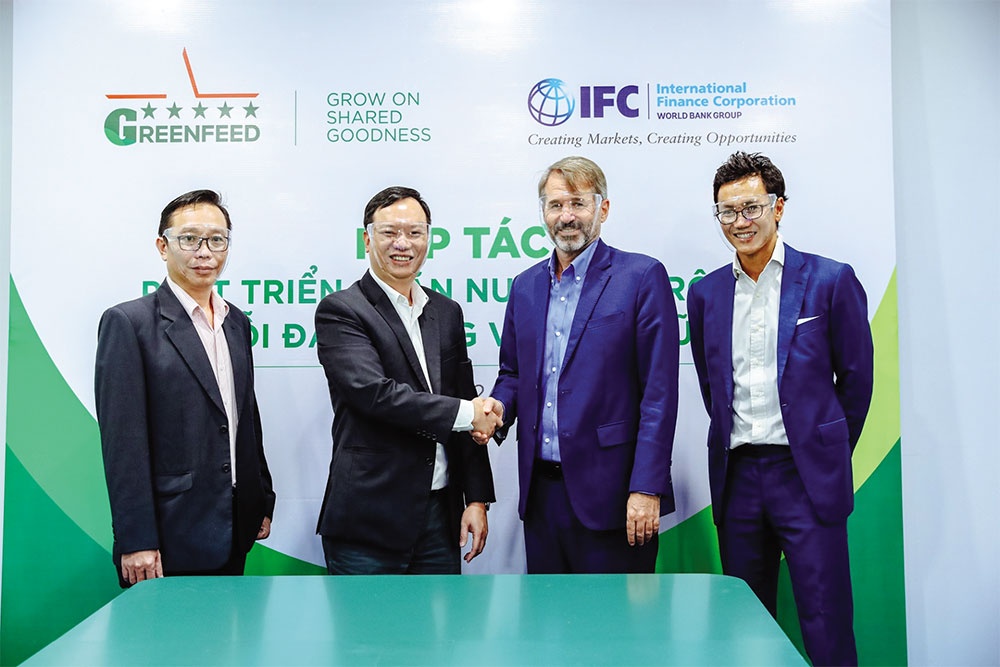Balancing short- and long-term goals at GREENFEED
How do domestic agricultural production enterprises in Vietnam take advantage of external support from other partners?
Along with the economic recovery, domestic agricultural production enterprises are facing new opportunities. To capture advantages from the market, enterprises gradually place greater emphasis on improving production capacity as well as optimising management and operation processes. This has attracted great interest from international investors.
In November 2021, GREENFEED officially received an investment of around $43 million from the International Finance Corporation under the World Bank Group through a 7-year bond initiative to scale up pig farming capacity, providing traceable and safe pork to meet the rising demand for animal-based food in Vietnam. Since then, we have been transforming towards modernisation, promoting sustainable and bio-secure livestock production to enhance domestic competitiveness and seek opportunities to expand to international markets.
 |
| GREENFEED Vietnam is all-in with its modernisation mission |
Why does a Vietnamese company specialising in animal feed want to enter the food market?
The feed-farm-food clean chain development model helps GREENFEED take advantage of the available benefits such as solutions for feed, breeding stock, and barn management to create outputs for the food industry that are healthy, delicious, and easily traceable – and also meet the increasing demand for safe and quality products of Vietnamese consumers.
In 2018, we began operating our Dong Nai Food Processing Factory, equipping the factory with advanced technology from Germany and Denmark to ensure compliance with international standards on food hygiene and safety.
At that time, we have launched food brands including G Kitchen, MAMACHOICE, Wyn, G•LALA, and French chicken brand LeBoucher. We aim to become an effective and reliable leading brand throughout the domestic and international food chain with outstanding technology applications.
The agricultural sector today is strongly affected by climate change while also causing huge amounts of greenhouse gas (GHG) emissions. What solutions can be implemented to implement net-zero practices in production and business activities?
The livestock sector and specific production activities are greatly affected by climate change. Therefore, it is necessary to have synchronous solutions to control risks for long-term stable development. One of the solutions is the effective control and treatment of animal waste and renewable clean energy regeneration, contributing to reducing GHG emissions.
We are currently implementing waste control through the separation and recovery of solid wastes for raising worms or composting to create fertiliser. Wastewater is put into the biogas cellar, then the biogas is treated and passes through a filter system to run a generator.
Rooftop solar power is also considered a solution to increase the proportion of renewables in the energy consumption structure.
Within the animal feed business, we are also constantly researching to optimise the nutritional formula and reduce feed conversion ratios to reduce the amount of animal waste to be treated.
We are developing a detailed roadmap for the implementation of net-zero emissions by 2050 with specific goals and solutions to be implemented for each business as soon as possible.
Financing for the transformation of tech and business to develop emission reduction models is always a big concern. So what is the biggest difficulty of such groups as yours in reducing GHG emissions to the environment?
The investment in technology that consumes less fuel or uses green energy to reduce GHG emissions requires huge capital. GREENFEED must also balance and set short, medium, and long-term plans in accordance with the group’s financial plan. Up to now, we have basically invested in and converted to biomass energy, deployed rooftop solar power models, and utilised biogas-based electricity generation on farms.
The practice shows that there are still certain difficulties in terms of technology, mobilisation of necessary resources, participation, and coordination of all stakeholders as well as the leadership and management of projects to achieve the set goals.
What kind of support does the business community expect from the government, and will ensuring emission reduction requirements help GREENFEED make your business more sustainable?
Challenges from emission reduction requirements prompt businesses to seek initiatives to further optimise production processes and save energy. In addition, we are also looking for alternative green energy sources such as using biomass instead of fossil fuels, focusing on solutions to manage and recover livestock waste to produce fertiliser or biogas.
The reality has proven that the successful implementation of solutions will contribute to optimal economic efficiency and more sustainable business.
To further promote this process, businesses expect that the management agencies will have more supportive policies in accessing investment resources to deploy green energy in a sustainable way, and support training to build management capacity.
In addition, a number of problems related to the promulgation of standards for post-treatment wastewater should also be removed. This will greatly contribute to reducing emissions and the use of chemical fertilisers for crops.
What the stars mean:
★ Poor ★ ★ Promising ★★★ Good ★★★★ Very good ★★★★★ Exceptional
Related Contents
Latest News
More News
- Heavy industries set for pilot greenhouse gas quotas (December 25, 2025 | 10:00)
- Swedfund invests in MSME growth and climate action in Vietnam (December 19, 2025 | 11:42)
- GreenYellow brings solar energy to light up remote schools in Tuyen Quang province (December 19, 2025 | 08:00)
- Charge+, Grab partner to develop EV charging network in Vietnam (December 18, 2025 | 17:11)
- Linking sci-tech and innovation to Vietnam’s net-zero future (December 18, 2025 | 14:31)
- Driving double-digit growth through green and circular transformation in Vietnam (December 17, 2025 | 09:00)
- Standard Chartered and ACCA deepen collaboration to develop Vietnam’s talent for a sustainable future (December 15, 2025 | 18:18)
- Schaeffler reports strong early output from Dong Nai solar project (December 12, 2025 | 15:16)
- Forestry conference highlights biodiversity and sustainability goals (December 09, 2025 | 13:35)
- Home Credit honoured among top 10 sustainable companies in trade and services (December 09, 2025 | 12:18)

 Tag:
Tag:





















 Mobile Version
Mobile Version